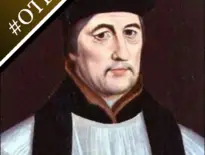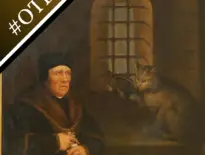On this day in Tudor history, 11th November, the Admiral of France landed on English soil, a visit that was going to cause George Boleyn, Lord Rochford, a lot of stress (1534); and Archbishop Cranmer was instructed to move Queen Catherine Howard from Hampton Court Palace to Syon House (1541)...
- 1491 – Birth of Martin Bucer, theologian and leading reformer, at Sélestat in Alsace. Bucer was the leading reformer of Strasbourg and was influenced by Martin Luther. His works included Defensio adversus axioma Catholicum, “Von der Waren Seelsorge” (“Concerning true pastoral care”), Gratulatio ad ecclesiam Anglicanam (“Congratulation to the English church”), “Bestendige Antworten (“Steadfast response”) and De ordinatione legitima (“On restoring lawful ordination”). While in exile in England in 1549, Bucer was commissioned to review the “Book of Common Prayer”.
- 1508 – Death of Sir Edward Brampton, soldier and merchant, at Lisbon in Portugal. He had been given a licence to settle in Portugal in 1487, and was known there as Duarte Brandão.
- 1534 - Philippe de Chabot, Seigneur De Brion and Admiral of France, landed on English soil. As the French ambassador to England, his visit was apparently intended to renew relations between England and France, so it was an important one. George Boleyn, Lord Rochford and brother of Queen Anne Boleyn, was chosen to meet the Admiral and escort him from Dover to London. See video below.
- 1541 – Catherine Howard, fifth wife of Henry VIII, was moved from Hampton Court Palace to Syon House where she was “examined touching Culpeper”, i.e. her alleged relationship with Thomas Culpeper, a member of her husband’s Privy Chamber. See video below.
- 1546 – Birth of Richard Madox, diarist and Church of England clergyman, in Shropshire. He is known for the diary he kept of Captain Edward Fenton's voyage to the Moluccas, while he was serving as Fenton's Chaplain and Secretary. Madox died during the voyage.
- 1563 – Burial of chronicler Henry Machyn (Machin) in London. He died after contracting the plague. Machyn is known for his chronicle “The Diary of Henry Machyn, Citizen and Merchant-Taylor of London, from A.D. 1550 to A.D. 1563”.
- 1593 – Death of Christopher Carleill, soldier and naval commander, in London. Carleill's naval and military career saw him serving in the Low Countries, France and Ireland. He also commanded the land force on Sir Francis Drake's expedition to Santo Domingo. Carleill was also known for his knowledge of mathematics, languages and his skill at poetry.
And today is also the Feast of Martinmas - click here for more.



It does seem that by placing her under the care of Edward Baynton and his wife that the king was showing his queen a certain amount of compassion, Edward was understandably the best man for the job in view of his previous position with Henry’s other queens, but his wife was her sister so whilst it was stressful for Isabel, it would also be a comfort for Catherine, so now she was moved to Syon House further down the river in Richmond, Syon house which still stands today and is a charming place to visit, set in beautiful countryside and is home to a butterfly sanctuary, for Henry’s fifth queen however it was a prison albeit a luxurious one, Cranmer was ordered to find out as much as possible and as more revelations came to light, so did Catherine’s suffering, we can see the very stark difference in Henry V111’s treatment of his second queen in relation to his fifth, months of intense investigations which began with Catherine being kept under guard at her apartments in Hampton Court, his ministers talking to members of her household and in her Step grandmothers household, the ageing Duchess of Norfolk, Dereham being pulled in for questioning and all the time, Cranmer having to interrogate the unhappy queen, then she was moved to Syon and Culpepers name came into the frame, with Anne Boleyn she nor her alleged lovers had been questioned over a lengthy period of time, the investigation into her so called adultery had not taken months and months, she had been told right away to collect her belongings and she was escorted to the Tower, in a few weeks she was dead, the victim of an evil coup, yet no such coup was ordained to make Catherine Howard fall, her so called betrayal genuinely shocked the king, so we can see why his treatment of both beheaded queens made his first look very suspect, Catherine still lived in comfort and was being treated with the respect according to her high status, it was said that she also became very imperious no doubt caused by the terror of her situation, but she only went to the Tower towards the end of her life, during the first interrogation she was overcome by weeping and she was described by Cranmer as being so lamentable it pities his heart, he must have felt sympathy towards her she was after all, young enough to be his daughter and I believe he hoped that the king would feel pity towards her to, alas it was not to be the queen had made him feel incredibly foolish, but these investigations were initially carried out as the king believed slander was being spread about her, yet as he soon discovered and Cranmer and the kings council, as well as her Howard relations, their pure young Catherine this wonderful example of womanhood was not all she had made herself out to be, Lady Rochford was also being interrogated and in panic, both women blamed the other for the queens misdeeds, in fact Lady Rochford was to die alongside her errant mistress for misprision of treason, no matter whom the queen met and why, it was Lady Rochfords duty to inform a higher authority, sadly this woman who had been in service for many years, who had survived the terror of the fall of her husbands family was destined to suffer their fate.
,